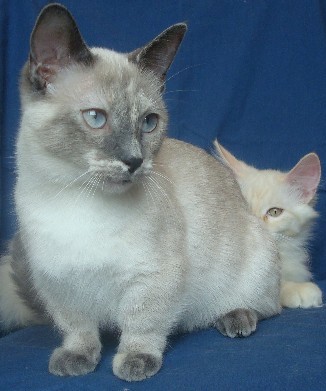The Munchkin is a relatively new breed, having its roots in the early 1980s, but the mutation that resulted in the shorter legs actually appeared sporadically throughout the 20th century. The first reported mutation occurred in Britain in 1944. Dr. HE Williams-Jones wrote an entire paper on four generations of short-legged cats. This line, which may very well have gone on to found an entire breed, was tragically lost during WWII (World War II).
Fortunately for the cat fancy world, the short-legged trait appeared again. Several times, in fact. It could be found in Stalingrad in the 1950s, New England in the 1970s, and Louisiana in the 1980s. It was in 1983 that Sandra Hockenedel found a pregnant cat who happened to have the shortened legs the Munchkin would become famous for. This cat, who she named Blackberry, would become the foundation for the modern Munchkin breed, though several outcrosses would be necessary to establish a diverse gene pool.
After a decade of careful outcrossing, the Munchkin was recognized by TICA (The International Cat Association) in 1994, but only in the New Breed development program. This program ensures that the breed is stable and healthy before championship status is granted. It was during this time that the gene which results in the shorter legs is actually dominant, much like the gene in the Corgi and Dachshund dog breeds. This helped with the breed's stability and in 2003 TICA granted the Munchkin cat breed championship status.
The Appearance of the Munchkin
The Munchkin cat looks very much like most other cat breeds, including the American Shorthair, except for the length of the legs. The mutation that makes these cats so unique shortens the leg bones, but does not affect any other part of the cat. So unlike the Corgi or Dachshund, the Munchkin doesn't have the back problems you might expect to see in a breed with such tiny legs. In fact, this breed has few health problems at all.
A medium-sized cat, the Munchkin typically weighs in between 5 and 9 pounds. Because of the early outcrossings, they can be of any color or pattern, so there is great variety in the Munchkin breed. They come in both longhaired and shorthaired varieties, the only difference between the two being the length of the coat. Shorthaired cats have an all-weather coat that is silky to the touch and requires only light grooming. Longhaired cats have an all-weather coat that is silky to the touch and requires more intensive grooming. Other than this slight difference, they are the same cat.
The Personality of the Munchkin
You might think this cat looks like a lot of fun, and you'd be right. They love to run and jump (though they can't jump as high as cats with longer legs) and will happily dash after whatever toy has been tossed for them. The Munchkin has a lot of energy and rarely slows down unless dinner is on the table.
The Munchkin has a sunny disposition and gets along with everyone from small children to strange dogs. They like everyone and want everyone's attention. A highly curious cat, this breed can sometimes get themselves into trouble with all their exploring, but you'll never want for excitement with this little bundle of energy around.
If you're looking for a cat that is unique and has a great personality, the Munchkin might be for you. They are happy and fun companions for the young and old alike. As long as you don't might a short little cat dashing around your living room at all hours.
